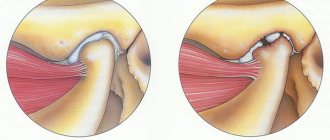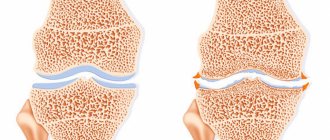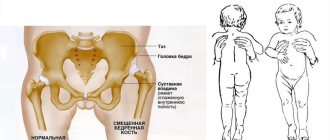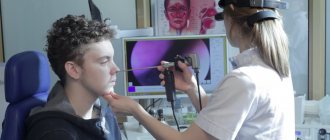Ankylosis is a disease in which bones fuse together. In this case, the activity of the joints is partially or completely blocked. In dentistry, a distinction is made between ankylosis of the TMJ (temporomandibular joint) and dental ankylosis, when the tooth fuses with the bone. Most often men are affected by it. To eliminate the disease, you should contact an orthodontist and a surgeon: the first one works to bring the bite back to normal, and the second one performs surgical treatment of TMJ ankylosis, removing abnormalities in the joint and restoring its mobility.
Causes of TMJ ankylosis
Ankylosis of the TMJ can be either an independent disease or a complication of diseases such as an inflammatory process with suppuration occurring inside the joint, a necrotic process occurring inside the bone and bone marrow, and purulent middle ear diseases. In the case when the development of ankylosis of the temporomandibular joint begins in early childhood and adolescence, the most likely reason for this is the entry of infectious pathogens into the blood, as a result of which the process of formation of abscesses begins in the joints and organs. The entry of infections into the blood of an adult can be the result of the presence of concomitant diseases (such as scarlet fever, gonorrhea or diphtheria) or the proximity of organs, bones or joints affected by various infectious bacteria.
No less often, during the diagnostic process, doctors determine that the cause of the development of ankylosis of the TMJ is the injury received, which caused a fixed fusion inside the joint. Pathology in the development of the joint may be a consequence of a difficult birth, when the delivery process was performed using medical forceps. A direct blow to the TMJ area in most cases leads to the development of ankylosis. In addition to displacement of the joint, a fracture of the articular bone and processes may occur, accompanied by bleeding in the joint cavity, and, as a result, the formation of hemarthrosis.
Also often in medical practice, in about 30 cases out of 100, TMJ ankylosis can be caused by chronic diseases.
What is ankylosis
Tooth ankylosis is a pathology characterized by fusion of the cement of the tooth with the jaw bone. The tooth root is deprived of part of the ligamentous apparatus, which often leads to adhesion or germination of bone tissue. The aesthetics of the teeth are disrupted, they look shorter and change their angle. Ankylosis usually occurs during tooth eruption. Pathology can also form at a late stage in the formation of the dental arch.
It is important to know. The process is accompanied by periodontal necrosis and the incorporation of root cement into the alveolar bone.
Ankylosis of a primary tooth is caused by loss of the periodontal ligament. It is observed in cases where a primary molar does not fall out due to the absence of a permanent dental unit. Ankylosed teeth are different in size from their neighbors, so bite correction will be required.
Classification of TMJ ankylosis
In order to select the most effective treatment plan (both medicinal and surgical) in medical practice, maxillofacial diseases are usually classified according to three main criteria:
- etymology of TMJ ankylosis;
- localization of temporomandibular joint ankylosis;
- structure of temporomandibular joint ankylosis.
By origin, the disease can be congenital or acquired. In the first case, TMJ ankylosis is diagnosed in children and adolescents, but very rarely. It is often a consequence of concomitant diseases of the face and jaw (for example, malocclusion). Acquired TMJ ankylosis can occur at any age, and the main causes of its occurrence are trauma or infection.
Depending on the location, the disease can be on one side or on both sides at once. Unilateral TMJ ankylosis is diagnosed in 93 out of 100 cases, the remaining 7 percent is occupied by bilateral ankylosis. Ankylosis of the TMJ, progressing on one side of the lower jaw, can equally affect both one and the other half of the face.
The structure of temporomandibular joint ankylosis can be fibrous or bone. The first type of disease is characteristic of mature patients, and bone ankylosis of the TMJ develops mainly in children. This is due to the fact that in childhood the process of bone formation is quite rapid, so bone fusion of the joint can occur.
Some experts also distinguish complete or partial ankylosis of the TMJ, depending on whether particles of cartilaginous tissue remain on the surface of the joint. In their absence, the patient is diagnosed with complete immobility of the lower jaw.
Ankylosis of bone
With bony ankylosis of the TMJ, the condylar process is connected to the zygomatic arch. In this case, the joint cavity is filled with bone tissue. This type of ankylosis can be complete or partial, in which intact areas remain on the articular surfaces. When only one of the two joints is affected, the face takes on an asymmetrical appearance. If both joints are affected, the upper jaw moves forward, the chin drops down, as a result of which the bite is disrupted, and problems arise not only with the teeth, but also with speech and breathing. Such a person eats solid food with great difficulty. In the full form of the disease, the joint gap is not visible during fluoroscopy; the condylar process appears wider than in the normal state.
Symptoms of TMJ ankylosis
The main symptom of the disease is impaired opening of the lower jaw. The patient notices that the process of eating becomes difficult due to pain when moving the jaw up and down. Speech dysfunction also becomes noticeable, which is caused by difficulties with fully opening the mouth.
Particular attention should be paid to the development of the disease in childhood, when the child cannot yet clearly formulate what exactly is bothering him. If parents notice that the baby’s teeth are not erupting well, there is an incorrect bite, or other dental pathology is noticed, it is necessary to contact a specialist for an examination. During the examination, it may be determined that the child’s facial skeleton is deformed and ankylosis of the TMJ develops.
When the jaw is affected by ankylosis of the TMJ on one side, most patients have a pronounced symptom in the form of a crossbite, and one can notice such a defect in facial symmetry as a displacement of the midline towards the affected joint.
Ankylosis of the TMJ, developing on both sides, changes the shape of the face in such a way that the lower jaw moves back, while the patient develops an anomaly in the form of a deep bite, prognathia or micrognathia (insufficient development of the lower jaw).
Due to the fact that ankylosis of the TMJ impairs chewing function, the patient stops eating food in a timely manner, which in childhood can cause the development of a disease such as malnutrition.
Impaired respiratory function is also noted as accompanying symptoms. If breathing is disrupted during sleep, the patient may experience a retraction of the tongue and attacks of apnea. Another symptom of TMJ ankylosis is the presence of plaque and hard deposits, dental caries, gingivitis and periodontitis, which is caused by the inability to perform high-quality oral hygiene.
Kinds
Today, several classifications of the pathology of the temporomandibular joint have been identified. The first is the division of the disease into congenital and acquired. Congenital ankylosis of the TMJ is quite rare, but occurs with greater bone deformation.
It is also possible to classify pathology according to the area of development - bilateral and unilateral. In the first case, damage to the joints on both sides occurs equally.
Today, a distinction is made between partial and complete ankylosis, depending on the degree of fusion of the joint and bone, fibrous and bone - according to the type of factor that caused the fusion.
Depending on the cause of the appearance, varying degrees of deformation of the patient’s face occur, so it is necessary to conduct a diagnosis to eliminate the factor influencing the pathology.
Clinical picture
The most common problem for patients with this pathology is the partial or complete inability to open the mouth to eat. Patients have a pronounced speech impediment and cannot eat normally, which causes them great problems.
It almost always causes deformation of the patient's face, which leads to a distortion of appearance. In addition, incorrect positioning of the lower jaw can cause disturbances in the growth of the dentition.
In childhood, ankylosis is dangerous because due to the inability to eat properly, such children often suffer from insufficient development of muscles and ligaments.
Children and adults suffering from the disease experience breathing problems - they wheeze, cannot take a deep breath, and also snore in their sleep. They cannot maintain proper oral hygiene, so they are more likely to have dental problems.
Diagnostics
The main stage of diagnosis is an examination, which clearly shows abnormalities on the side of the lesion - the patient’s lower jaw is deviated towards the fusion of the joint, the patient cannot open his mouth. Additional methods for diagnosing ankylosis are x-rays of the joint, which allows one to evaluate the degree and type of fusion, the absence of a joint capsule, as well as disturbances in the position of the joint in the lower jaw. It is important to carry out a differential diagnosis of ankylosis with diseases such as impaired joint mobility not associated with its fusion. After diagnosis, when the diagnosis is confirmed, it is necessary to take measures to correct the defect.
Therapeutic measures
| Click to sign up for a FREE consultation |
Treatment of incomplete fusions of the temporomandibular joint is carried out conservatively. Physiotherapeutic procedures and injections into the joints are prescribed as therapy. In other cases, it is treated only surgically, during which, under anesthesia, the deformation of the patient’s face is eliminated and the function of the joint is restored using special materials. As treatment, traction materials and osteotomy can be used, which make it possible to straighten and restore the function of the joint capsule. To summarize, we conclude: ankylosis is a dangerous disease that causes deformities and can lead to irreparable consequences. The main prevention of the disease is the prevention of injuries and purulent pathologies.
Diagnosis of temporomandibular joint ankylosis
The specialist primarily performs differential diagnosis, because temporomandibular joint ankylosis without complications has similar symptoms to mandibular contracture. You should also find out whether dysfunction of the lower jaw opening is the cause of the tumor. Diagnosis is performed by palpation in combination with x-rays.
The final diagnosis is established on the basis of complaints received from the patient and examination results, which indicate full or partial opening of the lower jaw, a change in the shape of the condylar process, and reduced or increased size of the lower jaw.
Treatment of TMJ ankylosis
If a patient is diagnosed with initial degree TMJ ankylosis, then conservative treatment will be sufficient. Treatment of temporomandibular joint ankylosis using this method consists of a course of physical therapy, special physical therapy, and medications most often prescribed are injections of natural medications (for example, hydrocortisone), which are placed in the area of the affected joint.
Fibrous formations present in the jaw joint must be dissected. In some cases, increased jaw opening is performed, while the patient is given general anesthesia.
If the disease cannot be eliminated with a conservative method, then treatment is performed surgically. This procedure will return the patient to full function of the lower jaw, and will also eliminate facial asymmetry.
To avoid the development of complications after surgical treatment, the lower jaw is fixed with special splints. In addition, a course of massage and chewing exercises is prescribed. Bite restoration after surgery is an integral part of orthodontic treatment. Orthodontic treatment is also performed to restore normal mobility of the lower jaw and give the dental arch an anatomical shape.
When treating TMJ ankylosis in children, a false joint is installed and the lower jaw is lengthened.
Dental ankylosis
You often encounter ankylosis of teeth if their number is incomplete. This birth defect can cause teeth and bones to fuse together. There are other possible causes of the disease. For example, if a baby tooth does not fall out in a timely manner or a molar does not begin to form. In this case, the root of the tooth can grow together with the alveolar process, and the tooth has a reduced height. In such cases, the best solution is to install an artificial crown, which allows you to correct the teeth and correct the bite.
Prognosis for recovery of a patient with TMJ ankylosis:
Ankylosis of the temporomandibular joint is a serious disease in the field of maxillofacial surgery and requires timely, properly selected and carried out treatment. If the disease is not treated at an early stage, then as it progresses it will develop into a severe form, which is characterized by significant changes in the shape of the facial skeleton, as well as many persistent disorders of speech functionality. Surgical treatment of ankylosis will allow the patient to correct most disorders: facial asymmetry, inability to open the lower jaw, breathing problems, and restore speech function. However, according to statistical data, in many cases a severe form of TMJ ankylosis is not completely cured and is accompanied by a deterioration in the patient’s condition even after treatment.
Diagnosis and treatment methods
The choice of treatment method is determined by the specifics of the negative syndromes caused by the pathology. The main criterion is the degree of limitation of the amplitude of mobility of the mandibular region. To identify the original source of the problem, a comprehensive diagnosis is carried out, including a hardware examination using radiographic and orthopantomographic imaging. The development of technology has supplemented the diagnostic list with CT and MRI procedures, thanks to which the current state of the joint space is assessed. An important factor is the differentiation of pathologies - an incorrect diagnosis, due to the similarity of symptoms characteristic of other diseases of the jaw, leads to incorrect treatment, increasing the duration of the recovery cycle.
Methods used in the early stages of pathology development include conservative therapeutic procedures, including physical therapy and redressal. In severe forms of pathology that are resistant to therapy, surgical intervention is recommended to correct the articular structure and eliminate deformity.
Prevention of TMJ ankylosis:
The main preventive measure that will allow you to avoid such a serious disease is the prevention and prevention of facial injuries in childhood, adolescence and adulthood. It is necessary to monitor and prevent the development of diseases associated with the purulent process in the body. At the slightest suspicion of such a disease, you should immediately contact a specialist and undergo an examination.
The most important thing in the prevention of TMJ ankylosis is the rehabilitation period after treatment, which should begin immediately. Another preventive measure is timely orthodontic treatment.
Predictions and prevention
With treatment and timely consultation with a doctor, the prognosis is good. But to improve the situation, additional preventive measures are required:
- mechanotherapy with dosed loads;
- physiotherapy (methods are determined by the doctor based on the results of treatment and the dynamics achieved);
- massage;
- myogymnastics.
Surgery may require additional treatment from an orthodontist. Mentoplasty is also often recommended for patients after surgery. The following situations increase the risk of complications:
- metabolic disorders in the body;
- rheumatism, gout, arthritis of various types;
- circulatory disorders.
Therefore, the Patient is required to monitor his health status, and if signs of deterioration appear, he should undergo an examination.
About Us
We offer treatment for diseases of the jaw, including TMJ ankylosis. We provide our patients with the following conditions and benefits:
- modern methods of therapy;
- use of certified materials;
- full range of services, including diagnostics;
- control of treatment, guarantee of results;
- attentive attitude towards everyone, creation of comfortable conditions;
- affordable prices.
You can make an appointment by phone. Leave a request on the website, choose a convenient time to visit our specialists, or send a request by email [email protected]










